JUNIOR DIVISION
Drew Bylow
St. Patrick School, Carleton, MI
Teacher: Maureen
Wickenheiser
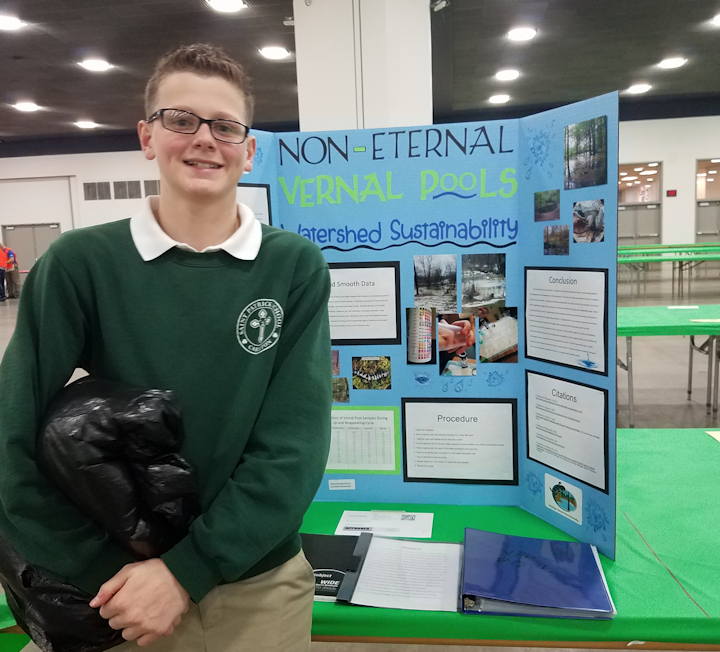
Non-Eternal Vernal Pools
Grand Award
Click on poster to see larger version
Abstract:
Vernal pools are wetlands that fill up annually but typically dry out
during part of the year. Vernal pools are important because they can
improve water quality by absorbing chemicals and other harmful
contaminants into the ground as the pool dries up. These substrates form
the bottom of the pool as it reappears. For my project I am testing to
determine if there is a change in the composition of the vernal pool
between the vernal pool drying up and reappearing. Testing for a variety
of synthetic chemicals and heavy metals that can be toxic to wildlife is
an important part of water quality monitoring. Important variables I used
to monitor water quality include pH, dissolved oxygen, sediment load,
nutrient levels such as nitrates and phosphates, and the amount of heavy
metals.
----------------------------
Anita Gaenko and Akshar Cowlagi
Clague Middle School, Ann Arbor, MI
Teacher: Laura Hannaford
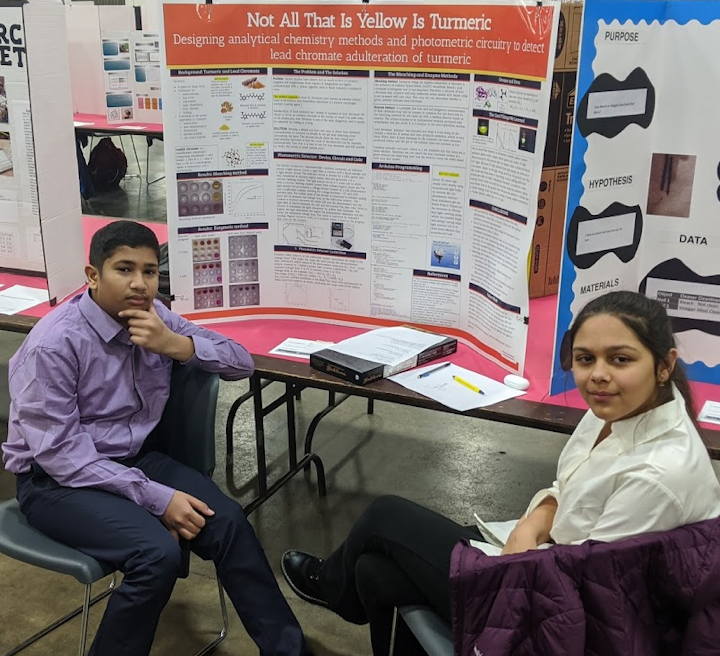
Not all that is yellow is turmeric
Grand Award
Abstract [edited]
1. Several new studies have shown that 80% of curcumin (turmeric)
supplies and supplements from countries like Bangladesh, Pakistan,
Myanmar, Indonesia, India, Vietnam, Malaysia and Cambodia are highly
contaminated with a yellow pigment to boost the color of turmeric
roots.
2. The yellow pigment is in fact lead (II) chromate PbCrO4 (also known as
chrome yellow and by various other names). As a result, the turmeric
powder
becomes contaminated by lead, which is neurotoxic, and hexavalent
chromium, which is a known carcinogen (cancer causing agent).
3. We plan to research and develop an easy and possibly inexpensive way to
detect lead chromate contamination in turmeric so people will not get lead
poisoning from consuming the spice.
SENIOR DIVISION
Anirudh Cowlagi
Huron High School, Ann Arbor, MI
Teacher: Andrew Collins
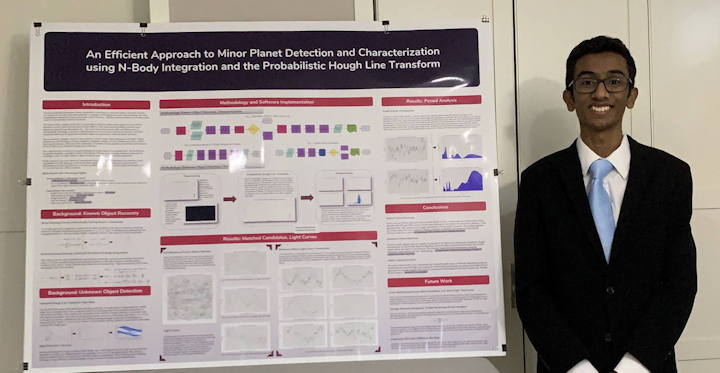
An Efficient Approach to Minor Planet Detection and
Characterization
using N-Body Integration and the Probabilistic Hough
Line Transform.
Grand Award
Abstract: Advances in the field of planetary science, particularly
concerning our own solar system, have been dramatic over the last few
decades. These advancements owe largely to developments in observing
technology and more comprehensive astronomical surveys across the world.
However, with these copious amounts of new data comes a need for more
effective methods of analysis. This project offers a solution to the issue
by presenting an efficient Python-based approach to aid with the
detection, recovery, and characterization of minor planets in the solar
system (asteroids, trans-neptunian objects, Kuiper Belt objects, etc.).
----------------------------
Andrew Yang
Washtenaw International High School, Ypsilanti Township, MI
Teacher: Daniel Giddings
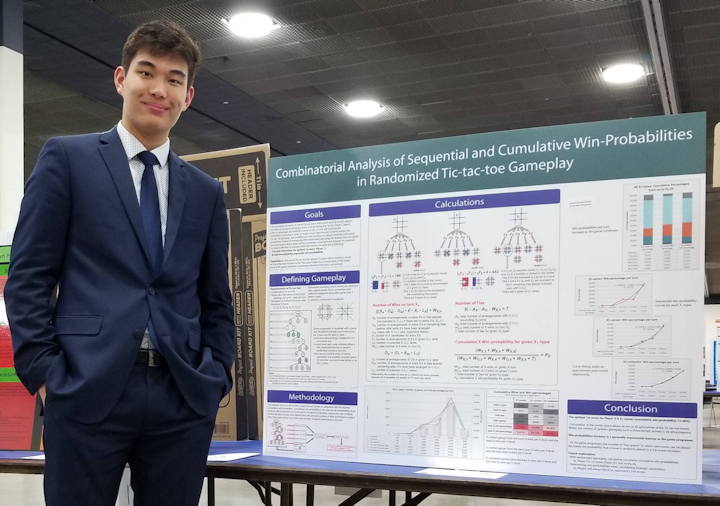
Combinatorial Analysis of Sequential and Cumulative
Win-Probabilities in
Randomized Tic-tac-toe Gameplay
First Place
Abstract: This investigation explores and analyzes the logical structure
of the well-known Tic-Tac-Toe game by dissecting gameplay, defining player
premises, determining the total number of possible conclusive games at
each turn, and comparing cumulative win-percentages based on Player X’s
first move. The symmetric properties of Tic-Tac-Toe gameplay are utilized
to streamline the quantifying process, and the win-probabilities at each
turn are also compared to characterize their evolution with game
progression. Ultimately, generalized formulas modeling the probability of
winning at any turn are extracted and discussed.
----------------------------
Amanda Xu
Huron High School
Teacher: Andrew Collins
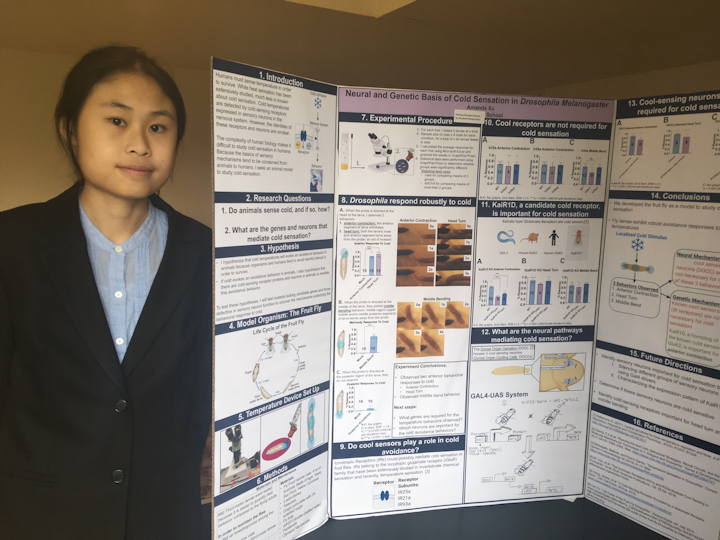
Neural and Genetic Basis of Cold Sensation
in Drosophila
Melanogastor
First Place
Rationale: All animals must sense temperature in order to
survive. Temperature cues are detected in the nervous system by sensory
neurons, and the basics of these mechanisms are largely conserved from
invertebrates to humans. The ability for sensory neurons to sense
temperatures depends on genes that encode temperature receptors.
Temperature receptors include ion channels. At a certain temperature,
these channels will open and allow ions/electrical signals to pass through
the neuron and send messages throughout the body to respond. While heat
sensation has been extensively studied, much less is known about cold
sensing. To investigate how organisms sense cold, I plan on using the
model organism Drosophila melanogaster, the fruit fly, which shares many
conserved genes with vertebrates. For over a century, the study of
fruit flies has told us much about humans, including neurobiology and
behavior.
Research Question: Do fruit flies sense cold, and if so, how? What are
the
neurons and genes that mediate cold sensation in Drosophila?
The Chapter has made our annual contribution to the Metro Detroit
Science Fair in
Cobo Center and we are honoring the winners from local schools.
Unfortunately, because of COVID-19, the Banquet, where we would have
had a chance to view these posters, had to be canceled.
Our hope and expectation is that the Banquet will be held in April/May
2021.
Other Science Fair Winners
2008
2009
2010
2011
2012
2013
2014
2015
2016
2017
2018
2019
{This one - 2020}





